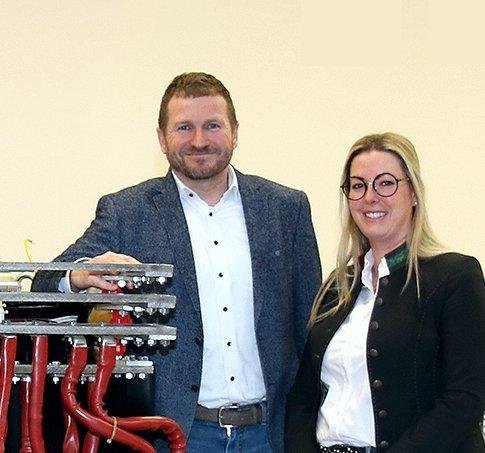1. Reichl: Modern power electronics are based on fast-switching semiconductor components. The steeper the switching edges, the more efficient the inverter. However, steep switching edges lead to strong harmonics, which cannot always be ironed by the DC link.
If the energy contained in these unwanted signals is not dissipated in a targeted manner, it often makes its way to the drives and is then uncontrollably converted into heat in the motor windings. If resonance effects between inductive components and parasitic capacitances also turn up, voltage peaks may occur that damage the insulation system of the drives in the long run. The result is then "inexplicable" motor, bearing and spindle damage – or even overvoltage damage to the drive inverters.
With appropriately designed filters, often water-cooled, we ensure that this parasitic energy is channelled into defined paths. The heated water can even be used for energy recovery. This is definitely smarter than heating the drives and then air-conditioning the heat from the hall.
Your filters contain both measures against conducted common-mode and differential-mode interference. Doesn’t this fundamentally increase the cost and reduce the efficiency?
2. Reichl: The material costs of the entire system do not necessarily increase. In some cases, other measures can be dispensed with, which have so far combated the symptoms of the malfunctions but not their causes.
To keep the amount of work on site as low as possible, we are increasingly supplying ready-to-install filters. Customers do not have to worry about the internal wiring; terminals and thus contact resistances between the individual components are eliminated.
On the other side of the equation is not infrequently reputation – or, even worse, contractual penalties. This happened recently with a well-known company. Unexpected failures had repeatedly occurred with drives on machine tools. The cause was a standard filter that was not adapted to the application. Although our AFE filter is more expensive, it is the most cost-effective solution because it eliminated the production downtime for the end customer.
We also don’t have to hide when it comes to the effects on the efficiency of the entire system. Quite the contrary. Because the close interaction between the developers of the power electronics and the specialists for the design of the inductive components is decisive here. This is precisely why our customers have direct access to our development department. When tricky questions arise, my colleagues sometimes go out with them, take a look on site and help interpret the measured values correctly.
Do you have a rule of thumb, for example, at what point it makes sense to think about an AFE filter in the DC link?
3. Reichl: Together with a globally active company in the field of high-performance drive systems, we looked at the causes and effects of potentially dangerous common-mode interference in a reference project, measured a lot, calculated, and tried out a few things. In the DC link, i.e., on the supply of the drive inverters, clocked voltage jumps to earth occur due to the principle. These lead to high leakage currents, which on the one hand seek their way to the motor windings, but on the other hand can also saturate the mains filter and thus render it ineffective.
These common-mode currents in the DC link are interference signals that flow back via the earth. An appropriately designed common-mode (filter) choke, also called a current-compensated choke, helps against this. In addition, Y-capacitors are used, additionally earthing high-frequency signal components directly at the DC servo drives.
According to our joint findings, the use of an AFE filter should always be considered in regenerative systems if:
- more than three drive inverters are used in the system,
- if a single motor cable is longer than 10 m, or
- if the cable lengths of all motor cables add up to more than 30 m.
Thank you very much for the interview, Mr. Reichl!
Dominik Reichl is the CEO of the family-run company Schmidbauer Transformatoren und Gerätebau GmbH from Hebertsfelden in Lower Bavaria, about 80 km east of Munich.
The company, with around 250 employees, is considered one of the leading developers and manufacturers of state-of-the-art inductive components for power electronics. Together with regional universities or the KIT, the company is constantly exploring the technical limits and developing solutions for switching frequencies up to 100 kHz, currents up to 2,700 A or power up to 2,700 kVA.
Founded in 1949 in Hebertsfelden, Lower Bavaria, about 80 km east of Munich, the family-run Schmidbauer Group of Companies today is a leading global specialist in application-specific inductive components. At two locations, around 250 employees develop and manufacture all kinds of inductive components, from small RF coils to large filter chokes, from filters for recuperating systems to customised power supplies – including for the world’s largest particle accelerator at CERN.
A top-class development department constantly explores the physical and technical limits and makes the company a sought-after partner worldwide for the development of energy-efficient drives in mobility and industry – or for test centres in battery production. At the same time, the company is occasionally ahead of its time: years ago, the water cooling system initiated by Schmidbauer was still smiled at, but today it has not only arrived in the broad field of power electronics, but is a global standard.
Numerous research projects and awards underline the innovative character of the family-owned company. Since 2010, the company has been continuously investing in sustainability and working to further reduce the ecological footprint of its products. For example, the 12,000 square metres of production, warehouse and office space have been heated exclusively by waste heat and heat pumps for the past two years.
Schmidbauer Transformatoren u. Gerätebau GmbH
Spanberg 16
84332 Hebertsfelden
Telefon: +49 (8721) 9662-0
Telefax: +49 (8721) 9662-50
http://www.schmidbauer.net
Marketing
E-Mail: vr@robologs.com
![]()

